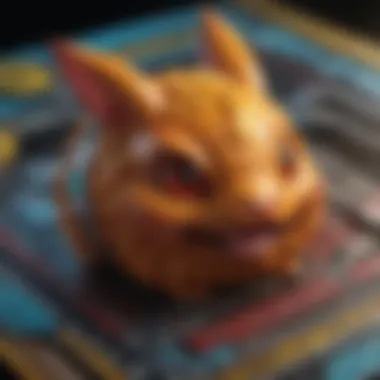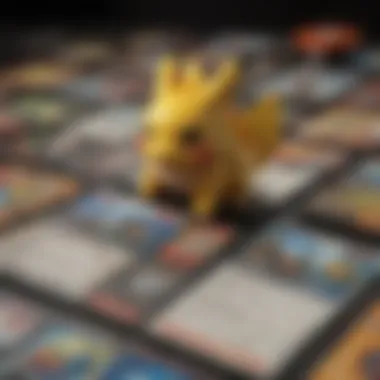The Value of Rare Pokémon Cards in Collecting


Intro
The world of Pokémon cards is as fascinating as ever, with collectors searching for the rarest items. These cards are not just colorful artwork; they represent years of nostalgia, strategy, and a deep connection to the Pokémon franchise. Understanding their value is essential for collectors and enthusiasts alike.
In this article, we will examine the various factors that influence the pricing of rare Pokémon cards, from market demand to their historical significance. Additionally, we will identify the specific cards that have garnered attention for their high price tags. We will also explore market trends to predict potential future valuations. This comprehensive guide aims to equip collectors with the knowledge they need to navigate this intricate landscape of collectible cards.
Games News
Latest Updates
In recent months, the collectible card market has seen a surge in interest. Various platforms, such as Facebook and Reddit, have become hotbeds for trading discussions. The recent introduction of new series and special edition cards has further increased excitement among players and collectors. With limited print runs, these cards are more valuable, as they generate buzz within the community.
Breaking Stories
Significant sales have made headlines, showcasing what collectors are willing to pay. Some transactions involve prices that are astonishing, like the sale of a rare Illustrator Pikachu card for over $200,000. Such events draw attention and can influence the market by potentially raising the value of similar cards.
Trending Topics
Discussions surrounding the psychology of collecting have gained traction. Collectors often consider rarity, condition, and personal connection when determining a card's value. The community debates about the authenticity of graded cards, which has become crucial for investment decisions.
Market Insights
Understanding the factors behind values can be intricate. Rarity is often the most important aspect, but other elements like demand, condition, and historical context play significant roles.
- Rarity: Cards that have limited prints naturally demand higher prices. Examples include tournament prize cards, which are often hard to find.
- Condition: Grading by reputable companies like PSA (Professional Sports Authenticator) impacts prices significantly. A card in mint condition can often sell for much more than a similar card that is not graded or has imperfections.
- Market Trends: Seasonal trends affect valuations. As more players return or new generations become interested, certain cards can see a rise in influence.
The valuation of Pokémon cards is not only a reflection of their rarity but also of the community and culture surrounding them.
Noteworthy Sales
Highlighting some of the noteworthy sales provides clearer insights into market dynamics. These sales often make waves and influence future valuations.
- Pikachu Illustrator Card: Sold for over $200,000, this card is often regarded as one of the rarest.
- Trophy cards: Exclusive cards given to winners of tournaments, these can fetch high prices, depending on the event's prestige.
The Future of Pokémon Card Valuation
Predicting the future is always uncertain. However, trends may indicate a growing interest, especially with the rise of digital collectibles and platforms that allow trading. Collectors may also see a shift in focus as new series and special editions are released. Investing in Pokémon cards seems to have a promising outlook, but collectors must educate themselves on the nuances of the market. The need for thorough research and cautious investment cannot be overstated.
Prelude to Pokémon Card Collecting
Pokémon card collecting has become a significant hobby for many individuals, intertwining nostalgia and strategic investment. This section introduces the topic by emphasizing its vital position in the broader context of collectible trading cards. One of the most intriguing aspects of this hobby is the diverse community of players, traders, and enthusiasts who are driven by a profound appreciation for the Pokémon universe.
As we explore the importance of this world, we will delve deeper into how it began and expanded into a formidable market. Furthermore, we need to consider various factors that enhance the appeal of collecting, such as the thrill of acquiring rare cards, the challenge of competition, and the pleasure of connecting with others who share similar passions. This understanding lays a foundation for evaluating the rarest cards, as it combines emotional attachment with tangible value.
The Origins of Pokémon Trading Cards
The Pokémon Trading Card Game (TCG) emerged in the late 20th century, specifically in 1996, coinciding with the rise of Pokémon as a cultural phenomenon. Originating in Japan, the cards were initially designed to complement the popular video games, anime, and merchandise. The core mechanics of the game involve strategic thinking and resource management, using a collection of cards to battle opponents. This strategy-based gameplay captivated not only children but also older fans who appreciated its depth.
Through the years, the trading card game evolved, differing editions and expansion sets introduced new mechanics and Pokémon. The collaboration between companies, like Nintendo and Creatures Inc., contributed significantly to its worldwide acceptance, allowing collectors access to exclusive cards. Understanding the origins provides insight into the evolution of value, rarity, and the cultural significance linked to these collectibles.
The Rise of Collectibility
Collecting Pokémon cards transformed from a casual activity to a lucrative pursuit. As the TCG's popularity spread across different demographics, so did the demand for specific cards. Some cards, due to their limited print runs or inherent game mechanics, became highly sought after in the collector's market.


This phenomenon has led to the establishment of various conventions, online communities, and auctions, where enthusiasts gather to exchange cards, discuss strategies, and showcase their collections. Moreover, the advent of grading services enhanced confidence in buying and selling, as these entities provide assessments of a card's condition and authenticity.
The value of specific cards skyrocketed as collectors recognized the financial potential in acquiring rare Pokémon. Examples of cards like the Illustrator Pikachu and Shadowless First Edition Charizard represent not just nostalgia but also a speculative investment. The cultural significance tied to these cards reflects broader social trends, illustrating how the Pokémon phenomenon remains relevant in contemporary culture.
"The Pokémon card collecting community reflects not only a passion for gaming but also the deep-rooted connections people have with their childhood experiences."
Rarest Pokémon Cards in Existence
The realm of Pokémon cards holds a special significance for collectors and enthusiasts, particularly when it comes to the rarest specimens. Understanding the rarest Pokémon cards is crucial, as these cards not only symbolize the rich history of the franchise but also serve as key indicators of market trends and collector sentiment. Rarity often translates into higher demand, leading to substantial financial valuations. This section will delve into the concept of rarity itself, explore key examples of rare cards, and discuss their importance in the broader context of Pokémon card collecting.
Understanding Rarity
Rarity is more than just a buzzword in the world of collectible cards. It is a fundamental concept that shapes the value of each card. A card's rarity can be defined by several factors: print runs, distribution methods, and the card's condition. The Pokémon Trading Card Game has various rarities assigned to cards, including common, uncommon, rare, holofoil, and ultra-rare. The less a card is produced, the more sought after it becomes.
Collector behavior typically leans towards acquiring cards that are scarce or unique. The allure lies in the exclusivity these cards offer. This influences market trends, often leading collectors to pay exorbitant amounts for limited-release cards. Understanding the dynamics of card rarity can provide significant insight into how collectors approach their collections and the investments they make.
Key Examples of Rare Cards
The following are notable examples of rare Pokémon cards that have not only captured the attention of collectors but have also achieved remarkable valuations in the market.
Illustrator Pikachu
Illustrator Pikachu stands as one of the most iconic examples of Pokémon cards. This card was awarded as a prize for a drawing contest held in Japan in 1998, making it incredibly rare. It possesses a few key characteristics that boost its value:
- Limited Print: Only around 39 copies of this card are known to exist.
- Artwork Significance: The card features unique artwork drawn by Atsuko Nishida, adding to its appeal.
Collectors often view Illustrator Pikachu as a must-have due to its historical significance and limited availability. However, the high price tag it commands can be a barrier for many enthusiasts. Acquiring this card often requires substantial investment.
Shadowless First Edition Charizard
The Shadowless First Edition Charizard card is another prime example of rarity and desirability. Released in the early days of the Pokémon Trading Card Game, it stands out due to its lack of a shadow on the right side of the artwork. Key aspects include:
- Cultural Impact: Charizard is one of the most recognizable Pokémon, which heightens the card's status.
- First Edition Mark: The first edition stamp adds an additional layer of exclusivity.
The appeal of this card lies not only in its rarity but also in its demand among collectors. It is often one of the highest-priced cards in various auction scenarios. However, the condition of the card plays a significant role in its valuation. A well-preserved card can fetch far more than one that shows wear.
Tournament Promo Cards
Tournament Promo Cards represent a distinct category within the realm of rare Pokémon cards. These promotional items were often only available at special events. They offer a few advantageous features:
- Event Exclusivity: Players and collectors received these cards through tournaments, making them rare.
- Design and Art: Many promo cards come with unique artwork or game mechanics that are different from standard cards.
The challenge in acquiring these cards often lies in their obscure origins and the limited audience who received them. Due to their limited distribution, they have become highly desirable items within the collector community. However, tournament cards can also vary greatly in price due to how well-known the specific tournament is or the card's popularity in gameplay.
Rarity drives demand. Understanding key rare cards helps collectors make informed decisions in the market.
Factors Influencing Card Valuation
Understanding the valuation of Pokémon cards is essential for both collectors and investors. The value of each card does not rest solely on its rarity, but several intricate factors influence it. These elements can range from the physical condition of the card to the market dynamics driven by trends and nostalgia. These factors create a complex web that defines how each card is valued in the marketplace, influencing decisions whether one is buying, selling, or collecting. A thorough grasp of these aspects can lead to more informed choices and potentially greater satisfaction in one's collecting journey.
Condition and Grading
Understanding PSA Grading


The PSA (Professional Sports Authenticator) grading system is a cornerstone of card valuation. It assesses the physical state of a card and assigns it a grade based on specific criteria. A card rated highly by PSA can significantly outpace its lower-graded counterparts in terms of price. The key characteristic of the PSA system is its objectivity, which is known for being reliable among collectors. A unique feature of PSA grading is the encapsulation process; cards are sealed in a tamper-evident casing that preserves their condition. This can be a double-edged sword: while it enhances protection and can fetch a higher price, it also restricts the ability to examine the card directly.
Cultural Significance of Mint Condition
Mint condition remains a pivotal concept in the Pokémon card community. The definition of "mint" varies, but generally, it denotes a card that shows no visible wear. Such cards command respect and a higher price tag. The cultural significance of mint condition lies in its representation of quality and desirability. Collectors seek mint condition cards not just as investments but as objects of appreciation. The downside is that achieving or maintaining this level of condition can require considerable effort and resources. Cards that aren’t in mint condition often struggle to attract attention despite their rarity.
Market Demand Dynamics
Trends in Collector Interest
Collector interest is a key element affecting the value of Pokémon cards. In recent years, there has been a notable surge in interest among diverse demographics; this includes older fans who grew up with Pokémon as well as a younger generation discovering it anew. The appeal of nostalgia combined with current trends in gaming culture creates parameters for evolving collector interest. The unique feature of this trend is its unpredictability. While sudden spikes in interest can elevate values overnight, they also impose risks, as market sentiment can shift just as rapidly.
The Role of Nostalgia
Nostalgia plays a crucial role in the valuation of Pokémon cards. For many, these cards are not merely collectibles; they represent cherished memories from childhood. The emotional connection significantly influences how much collectors are willing to pay. This emotional value contributes to the perception of a card's worth. However, nostalgia can also lead to irrational purchasing behaviors. Prices can sometimes soar based on sentiment rather than logic, creating volatility in market values.
Market Comparisons
Comparative Analysis with Other Trading Cards
Understanding how Pokémon cards compare to other trading cards adds depth to valuation. The market for trading cards is varied; for example, sports cards have long been established, while other brands like Magic: The Gathering are also significant players. The comparative analysis reveals that certain Pokémon cards, particularly vintage or rare ones, often outshine others in terms of auction values. This could be due to the unique cultural phenomenon Pokémon represents. However, this environment can become highly competitive, making it crucial for collectors to stay informed on market dynamics.
Long-term Value vs. Short-term Investment
In the landscape of card collecting, a clear distinction exists between long-term value and short-term investment. Long-term value is often associated with established cards that have a historical significance or sentimental value. On the other hand, short-term investment tends to focus on rapidly fluctuating trends and emerging cards. The benefit of considering long-term value is the potential for stability in fluctuating markets. However, it may limit opportunities for quicker gains often associated with short-term investments. This contrast highlights the importance of strategy in collecting or investing in Pokémon cards.
Noteworthy Sales and Auctions
Noteworthy sales and auctions play a pivotal role in understanding the overall landscape of Pokémon card valuation. They provide real-world examples of the shifting value of specific cards based on collector demand, rarity, and market dynamics. In this section, we delve into how these transactions reflect broader trends within the community and how they can serve as benchmarks for collectors looking to assess their own cards.
Record Sales Overview
Record sales of rare Pokémon cards signify more than just high prices; they embody the peak of what collectors are willing to pay. Such sales can set a precedent for future values, influencing buyer perception and market behavior. For example, when a card sells for an unprecedented amount, it often leads to a revaluation of similar cards, prompting collectors to rethink their strategies.
Understanding these record sales is vital for anyone involved in collecting. They illustrate not only the rarity and desirability of specific cards but also the evolving nature of the market.
Influential Auctions
The Charizard Record Sale
The 2021 Charizard record sale is a significant milestone in the collecting community. This iconic Pokémon card, which features the franchise's beloved character, fetched a staggering price at auction. Its sale demonstrated not only the card's inherent popularity but also its status as a cultural symbol among fans.
What makes this sale particularly noteworthy is the card's grading. The card was graded 10 by PSA, making it one of the finest examples available. This aspect highlights the importance of condition in determining the value of rare Pokémon cards. Moreover, the sale has been cited as a catalyst for increased interest in other first-edition cards.
The Charizard's record price exemplifies how a single sale can affect collector sentiment and spark new interest in the market. Its unique feature, a combination of nostalgia and rarity, presents both potential advantages and disadvantages. Collectors must consider whether they aim to acquire cards primarily for investment or for personal enjoyment.
Recent Auction Trends
Recent auction trends reflect an increasingly active and competitive market for Pokémon cards. Notably, many auctions see multiple bids ascending rapidly, indicating heightened demand. This trend underscores the growing interest in Pokémon cards as viable investments.
What characterizes these recent auctions is the diversity of cards being sold. From vintage items to modern promotional cards, the market is expanding. This variety allows collectors to diversify their portfolios or focus on specific niches.
However, with rising competition comes the challenge of discerning between true value and speculative pricing. Many collectors are now advised to perform due diligence before participating in auctions.


"Understanding auction dynamics is crucial for any collector. It provides insight into fair market value and helps avoid inflated pricing."
The Future of Pokémon Card Valuation
Understanding the future of Pokémon card valuation is essential for collectors and investors alike. As the market evolves, certain trends will determine how the value of these cards changes. With the rise of digital technology and shifting collector interests, what was once predictable can become complex. How these aspects align will shape market behavior. Knowing where the industry is heading may help participants make informed decisions.
Predictions for Upcoming Trends
Several predictions can be made regarding the future of Pokémon card valuation. The first trend is the enhancement of digital items and collectibles. As technology advances, collectors may focus more on digital versions of their favorite cards. This change can influence the demand for physical cards. Another trend points to growing interest in minority categories. Cards that are less well-known may gain popularity, leading to price fluctuations. Overall, staying informed will help collectors navigate these changes.
Impact of Digital Collectibles
The rise of digital collectibles has changed how collectors engage with valuable items. Integrating technology into the collectible market offers new platforms for trading and showcasing cards. This development fosters a unique community among collectors.
NFTs and Their Influence
Non-Fungible Tokens (NFTs) have gained popular attention. They represent ownership of digital assets in a unique way. NFTs offer authenticity and scarcity for digital Pokémon cards. This aspect makes them appealing for many collectors. They provide a new form of valuation that can show how certain cards might appreciate over time. On the downside, the market for NFTs can be volatile. The price of digital items often fluctuates rapidly. Therefore, while they can enhance a collection, they also present potential risks.
The Intersection of Digital and Physical Collectibles
The mingling of digital and physical collectibles has broadened opportunities for collectors. It allows for new ways to connect with audiences. For example, some physical cards may now come with digital counterparts, amplifying their appeal. This integration creates a comprehensive approach to card collecting, combining nostalgia with modern technology.
The unique feature of this intersection is the ability to own both types of collectibles. This ownership can enhance a collector's portfolio while showcasing items in different formats. However, collectors must be cautious of the distinction between the two forms. Physical cards still have a robust historical significance, while digital cards offer immediacy and the allure of innovation. Balancing these aspects will be critical as both markets grow.
"The landscape of collectibles is changing. Understanding these shifts ensures that collectors can make wise investments."
Collecting Strategies for enthusiasts
Collecting Pokémon cards can be a fulfilling endeavor as it combines nostalgia with the thrill of investment. To maximize the value of one’s collection, strategic planning is essential. Enthusiasts must adopt informed approaches in identifying valuable cards and employing effective preservation techniques. Understanding these strategies not only increases the likelihood of making wise acquisitions but also enhances long-term satisfaction and value retention of the collections.
Identifying Valuable Cards to Acquire
Knowing how to identify valuable cards is crucial. The rarer a card, the more it can command in the market. Here are some strategies to help pinpoint valuable acquisitions:
- Research Provenance: Understanding the history behind a card can affect its value. Cards with documented rarity or unique characteristics usually fetch higher prices.
- Follow Market Trends: Keeping an eye on market shifts is vital. Platforms like eBay and auction sites can provide insights into which cards are gaining traction among collectors.
- Engage with Collector Communities: Forums such as Reddit and Facebook groups are helpful. Enthusiasts share insights, discuss trends, and can offer tips on forthcoming cards that might inflate in value.
- Focus on Grades: Cards that receive a high grade from grading services, such as PSA, often appreciate faster than those with lower grades. Emphasize quality over quantity.
Preservation Techniques
Once valuable cards are acquired, effective preservation ensures their longevity and sustained value. Here are several recommended techniques:
- Use Sleeves and Toploaders: Protect cards in sleeves, and store them in rigid toploaders. This prevents physical damage and environmental harm.
- Maintain Ideal Conditions: Keep cards in a cool, dry place away from direct sunlight. High humidity levels can cause cards to warp or discolor.
- Regularly Check Condition: Periodically inspect the cards for any signs of deterioration. Early detection of issues allows for timely action to avoid serious damage.
- Avoid Manipulative Handling: Minimize handling by using gloves when touching cards. Oils from your fingers can leave marks or damage surfaces.
"A well-preserved card holds its value significantly more than one that is left to deteriorate."
By employing these strategies, enthusiasts can make informed decisions to enhance their collections. This not only contributes to their personal enjoyment but positions them to benefit from the growing market of Pokémon collectible cards.
Closure
The conclusion serves as a critical summary of the major insights and themes presented in this article regarding the rarest Pokémon cards. By distilling the key points discussed, readers can consolidate their understanding of the intricate dynamics of Pokémon card collecting. This section aims to reinforce the significance of rarity, market demand, and the valuation process while also addressing the future landscape of the collectible card market.
Recap of Key Insights
- Importance of Rarity: The rarity of specific cards, such as the Illustrator Pikachu and Shadowless First Edition Charizard, heavily influences their market value. Collectors need to recognize which cards hold significant rarity to inform their purchasing decisions.
- Valuation Factors: The condition and grading of cards play crucial roles in determining prices. Knowing the grading systems, such as PSA Grading, is vital for collectors to understand what defines a card's worth.
- Market Trends: Understanding the ever-evolving market demand helps collectors predict which cards might increase in value over time. Trends can be influenced by various factors, including nostalgia and pop culture impacts.
- Noteworthy Sales: Significant auction sales demonstrate the interests and spending limits of high-end collectors, marking trends that can affect future card valuations.
- Future Considerations: With the rise of digital collectibles, there is growing speculation on how this will interact with traditional card collecting. Insights on the potential shift towards NFTs and digital trading cards can help collectors navigate future investment strategies.
Reflecting on the Evolution of Collecting
The evolution of Pokémon card collecting reflects broader societal shifts around collectibles. Initially, collectibles were often seen as mere childhood pastimes. Over the years, Pokémon cards have transformed into significant financial assets that attract serious investors and collectors alike.
The community around Pokémon card collecting has seen an increase in engagement, driven by various online platforms. Communities on websites like Reddit and Facebook serve as hubs for discussion, trading, and education regarding cards, enhancing the overall landscape of collecting.
Moreover, today’s collectors are more informed than previous generations. They approach collecting with strategic mindsets, understanding valuation factors, and market dynamics. Collecting has evolved from casual arrangements to a well-researched form of investment. As this interest continues to grow, it's essential for collectors to stay informed about developments in the market to make sound decisions.



